Effectiveness Measures
- Early and adequate prenatal care.
- Receipt of recommended immunizations by young children.
- Children’s vision screening.
- Well-child visits in the last year.
- Receipt of meningococcal vaccine by adolescents.
- Receipt of human papillomavirus (HPV) vaccination by adolescents.
Prevention: Early and Adequate Prenatal Care
- A Healthy People 2020 objective is for 77.6% of pregnant women to receive early and adequate prenatal care:
- Definition is based on Adequacy of Prenatal Care Utilization Index.
- For a given pregnancy, the target number of prenatal visits considered adequate is determined by the start date of prenatal care and the infant’s gestational age at birth.
Infants born in 2013 whose mothers had obtained early and adequate prenatal care, by State quartiles
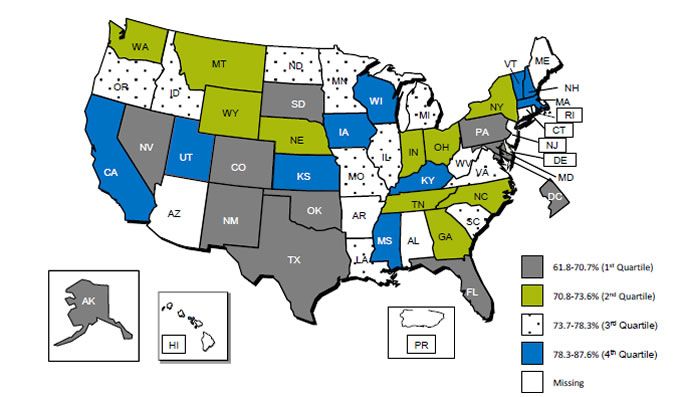
Source: Centers for Disease Control and Prevention, National Center for Health Statistics, National Vital Statistics System, 2013.
Notes: Quartile values may overlap due to rounding.
Because of changes between the 1998 and 2003 versions of birth certificates, prenatal care timing and adequacy were evaluated only for the District of Columbia and the 41 States using the 2003 standard birth certificate for all of 2013. Data for 2013 were only available for these 42 State-equivalent jurisdictions, so national estimates were not generated. However, these 42 jurisdictions accounted for more than 86% of live births in the United States in 2013. The State-equivalent jurisdictions (AL, AR, AZ, CT, HI, ME, NJ, PR, RI, and WV) not using the 2003 version of the birth certificate did not have data available for this measure and are categorized as “missing” on the map.
To classify the adequacy of prenatal care services, the reported number of visits is compared with the expected number of visits for the period between when care began and the delivery date. Completeness of reporting varies by item and State. In 2013, two States were missing responses on more than 10% of the birth certificates (GA-15.9%; NV-12.9%). The impact of the comparatively high level of unknown data is not clear. Comparisons including information from these States should be made with caution. More detailed information is available in the 2013 Natality Data Users Guide: ftp://ftp.cdc.gov/pub/Health_Statistics/NCHS/Dataset_Documentation/DVS/natality/UserGuide2013.pdf (1.4 MB).
- Overall: This map shows overall rankings by quartile in the percentage of infants born to women who received early and adequate prenatal care in 2013, for Washington, DC, and 41 States. Values ranged from 61.8% to 87.6%.
- Differences by State: Interquartile ranges follow:
- First quartile (lowest): 61.8%-70.7% (AK, CO, DC, FL, MD, NM, NV, OK, PA, SD, TX).
- Second quartile (second lowest): 70.8%-73.6% (GA, IN, MT, NE, NY, NC, OH, TN, WA, WY).
- Third quartile (second highest): 73.7%-78.3% (DE, ID, IL, LA, MI, MN, MO, ND, OR, SC, VA).
- Fourth quartile (highest): 78.3%-87.6 % (CA, IA, KS, KY, MA, MS, NH, UT, VT, WI).
Absolute differences in receipt of early and adequate prenatal care between White and Black infants born in 2013, by State quartiles
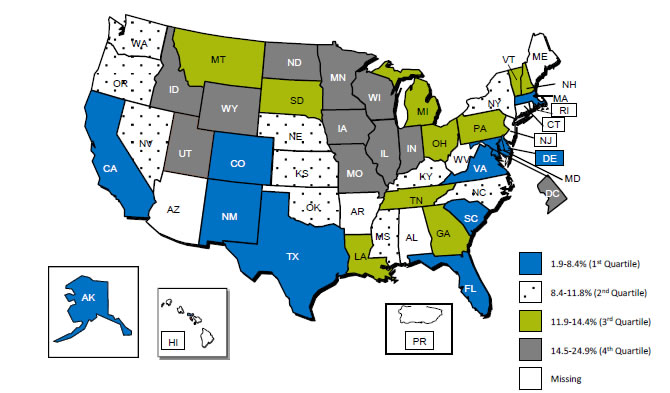
Source: Centers for Disease Control and Prevention, National Center for Health Statistics, Division of Vital Statistics, National Vital Statistics System, 2013.
Notes: For this measure, lower values are better. Quartile values may overlap due to rounding.
Because of changes between the 1998 and 2003 versions of birth certificates, prenatal care timing and adequacy were evaluated only for the District of Columbia and the 41 States using the 2003 standard birth certificate for all of 2013. Data for 2013 were only available for these 42 State-equivalent jurisdictions, so national estimates were not generated. However, these 42 jurisdictions accounted for more than 86% of live births in the United States in 2013. The State-equivalent jurisdictions (AL, AR, AZ, CT, HI, ME, NJ, PR, RI, and WV) not using the 2003 version of the birth certificate did not have data available for this measure and are categorized as “missing” on the map.
To classify the adequacy of prenatal care services, the reported number of visits is compared with the expected number of visits for the period between when care began and the delivery date. Completeness of reporting varies by item and State. In 2013, two States were missing responses on more than 10% of the birth certificates (GA-15.9%; NV-12.9%). The impact of the comparatively high level of unknown data is not clear. Comparisons including information from these States should be made with caution. More detailed information is available in the 2013 Natality Data Users Guide: ftp://ftp.cdc.gov/pub/Health_Statistics/NCHS/Dataset_Documentation/DVS/natality/UserGuide2013.pdf (1.4 MB).
- Overall: This map shows overall State-equivalent rankings by quartile for the absolute differences between percentages of White and Black infants born in 2013 whose mothers obtained early and adequate prenatal care. Differences ranged from 1.9% to 24.9% (lower is better).
- Differences by State: Interquartile ranges follow:
- First quartile (smallest absolute difference): 1.9 %-8.4% (AK, CA, CO, DE, FL, MA, MD, NM, SC, TX, VA).
- Second quartile: 8.4%-11.8 (KS, KY, MS, NE, NV, NY, NC, OK, OR, WA).
- Third quartile: 11.9%-14.4% (GA, LA, MI, MT, NH, OH, PA, SD, TN, VT).
- Fourth quartile (largest absolute difference): 14.5%-24.9% (DC, ID, IL, IN, IA, MN, MO, ND, UT, WI, WY).
Prevention: Receipt of Recommended Vaccinations by Young Children
- Immunizations reduce mortality and morbidity by:
- Protecting recipients from illness.
- Protecting others in the community who are not vaccinated.
- Beginning in 2007, seven vaccines were recommended to be completed by ages 19-35 months. The recommended vaccines are:
- Diphtheria-tetanus-pertussis vaccine.
- Polio vaccine.
- Measles-mumps-rubella vaccine.
- Haemophilus influenzae type B vaccine.
- Hepatitis B vaccine.
- Varicella vaccine.
- Pneumococcal conjugate vaccine.
These vaccines constitute the 4:3:1:3:3:1:4 vaccine series tracked in Healthy People 2020.
- The Healthy People 2020 target is 80% coverage in the population ages 19-35 months.
- The U.S. Surgeon General, Dr. Vivek H. Murthy, and Elmo want everyone to stay healthy and get vaccinated! https://youtu.be/viS1ps0r4K0
Children ages 19-35 months who received the 4:3:1:3:3:1:4 vaccine series, by household income and race/ethnicity, 2009-2013
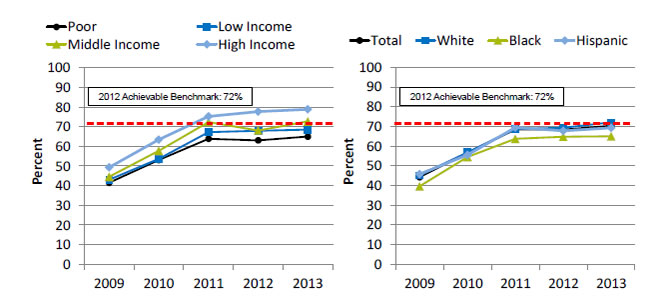
Left Chart:
| Income | 2009 | 2010 | 2011 | 2012 | 2013 |
|---|---|---|---|---|---|
| Poor | 41.6 | 53.1 | 63.9 | 63.1 | 65.0 |
| Low Income | 43.1 | 53.7 | 67.2 | 68.0 | 68.5 |
| Middle Income | 44.6 | 57.8 | 72.4 | 68.1 | 72.7 |
| High Income | 49.3 | 63.5 | 75.2 | 77.7 | 78.9 |
Right Chart:
| Race / Ethnicity | 2009 | 2010 | 2011 | 2012 | 2013 |
|---|---|---|---|---|---|
| Total | 44.3 | 56.6 | 68.5 | 68.4 | 70.4 |
| Hispanic | 45.9 | 55.5 | 69.5 | 67.8 | 69.3 |
| Black | 39.6 | 54.5 | 63.7 | 64.8 | 65.0 |
| White | 45.2 | 56.9 | 68.8 | 69.3 | 72.1 |
2012 Achievable Benchmark: 72%.
Source: Centers for Disease Control and Prevention, National Center for Health Statistics and National Center for Immunization and Respiratory Diseases, National Immunization Survey, 2009-2013.
Note: White and Black are non-Hispanic. Hispanic includes all races. The 4:3:1:3:3:1:4 vaccine series refers to 4 or more doses of diphtheria and tetanus toxoids and pertussis vaccine, or diphtheria and tetanus toxoids; 3 or more doses of poliovirus vaccine; 1 or more doses of measles antigen-containing vaccine, including measles-mumps-rubella; 3 or more doses of Haemophilus influenzae type b (Hib) vaccine; 3 or more doses of hepatitis B vaccine; 1 or more doses of varicella vaccine; and 4 or more doses of pneumococcal conjugate vaccine. Full series of Hib vaccine is ≥3 or ≥4 doses, depending on brand type.
- Overall: in 2013, the percentage of children ages 19-35 months who received the 4:3:1:3:3:1:4 vaccination series was 70.4%.
- Trends: From 2009 to 2013, the percentage of children ages 19-35 months who received the 4:3:1:3:3:1:4 vaccination series improved overall and for all income and racial/ethnic groups.
- Groups With Disparities:
- In 2013, the percentage of children ages 19-35 months who received all the recommended vaccines was lower for children from poor, low and middle income families compared to those from high income families.
- In 2013, the percentage of Black children (65.0%) ages 19-35 who received all the recommended vaccines was lower compared to White children (72.1%).
- Achievable Benchmark:
- The 2012 top 5 State achievable benchmark was 72%. The top 5 States that contributed to the achievable benchmark are Louisiana, Maryland, Massachusetts, New Hampshire, and Ohio.
- Children from high-income households and middle-income households have achieved the benchmark. White children also have achieved the benchmark.
- Children overall and children from poor and low-income households could achieve the benchmark in approximately a year. Black and Hispanic children also could achieve the benchmark within a year.
Prevention: Children’s Vision Screening
- Vision checks for children may detect problems of which children and their parents were previously unaware.6
- Early detection also improves the chances that corrective treatments will be effective.6
Children ages 3-5 years who ever had their vision checked by a health provider, by race/ethnicity, United States, 2002-2013
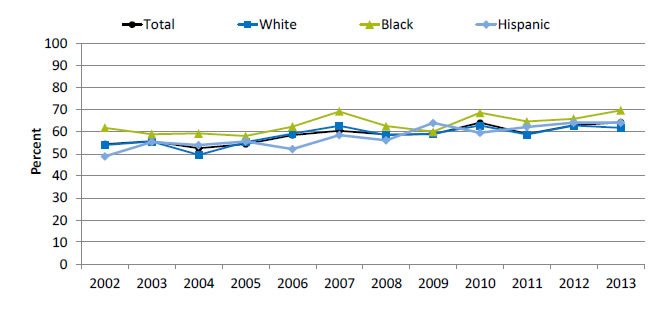
| Year | Total | White | Black | Hispanic |
|---|---|---|---|---|
| 2002 | 54.5 | 54.0 | 61.9 | 48.9 |
| 2003 | 55.8 | 55.6 | 59.0 | 55.4 |
| 2004 | 52.6 | 49.6 | 59.3 | 54.0 |
| 2005 | 54.4 | 55.4 | 58.1 | 55.7 |
| 2006 | 58.5 | 59.2 | 62.4 | 52.2 |
| 2007 | 60.5 | 62.8 | 69.3 | 58.5 |
| 2008 | 58.8 | 58.6 | 62.6 | 56.1 |
| 2009 | 58.9 | 59.2 | 60.1 | 64.1 |
| 2010 | 64.2 | 62.9 | 68.7 | 59.6 |
| 2011 | 59.1 | 58.8 | 64.7 | 62.3 |
| 2012 | 63.0 | 62.9 | 66.0 | 64.2 |
| 2013 | 64.4 | 61.9 | 69.8 | 64.2 |
Source: Agency for Healthcare Research and Quality, Medical Expenditure Panel Survey, 2002-2012.
Note: White and Black are non-Hispanic. Hispanic includes all races.
- Trends:
- From 2002 to 2013, the percentage of children ages 3-5 years who had ever received a vision check by a health provider increased from 54.5% to 64.4%.
- Among White children ages 3-5 years, the percentage who had ever received a vision check by a health provider increased from 54% in 2002 to 61.9% in 2013. The percentage also increased for Hispanic children from 48.9% in 2002 to 64.2% in 2013. However, there was no statistically significant increase for Black children (61.9% in 2002 and 69.8% in 2013).
- Groups With Disparities:
- In 2013, there were no statistically significant differences between White, Black, and Hispanic children in the percentage who had ever received a vision check (61.9%, 69.8%, and 64.2%, respectively).
Prevention: Well-Child Visits in the Last Year
- The American Academy of Pediatrics recommends annual preventive health care visits for all children.7 Current (2014) recommendations for visits:
- 7 well-child visits before 12 months of age.
- 6 well-child visits between 12 and 36 months of age.
- 1 well-child visit per year from ages 3 to 21 years.
- The Affordable Care Act requires insurance plans to cover well-child visits with no copayments or deductibles.8
- A Healthy People 2020 objective is to improve the rate of adolescent well visits.9
Children ages 0-17 with a well-child visit in the last 12 months, by race/ethnicity and family income, 2000-2014
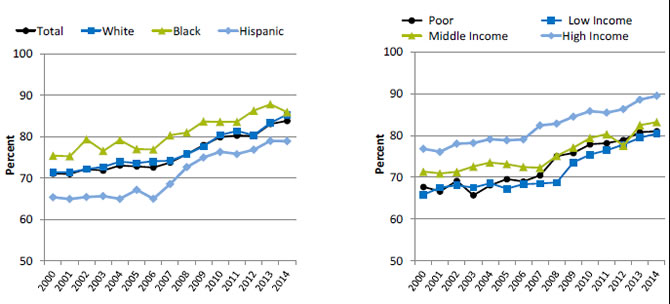
Left Chart:
| Year | Total | White | Black | Hispanic |
|---|---|---|---|---|
| 2000 | 71.0 | 71.3 | 75.4 | 65.3 |
| 2001 | 71.0 | 71.4 | 75.2 | 64.9 |
| 2002 | 72.1 | 72.1 | 79.4 | 65.4 |
| 2003 | 71.8 | 72.7 | 76.5 | 65.6 |
| 2004 | 73.0 | 73.9 | 79.2 | 64.9 |
| 2005 | 72.8 | 73.6 | 77.0 | 67.1 |
| 2006 | 72.5 | 74.0 | 76.9 | 64.9 |
| 2007 | 73.7 | 74.1 | 80.3 | 68.5 |
| 2008 | 75.8 | 75.7 | 81.0 | 72.6 |
| 2009 | 78.0 | 77.6 | 83.6 | 74.9 |
| 2010 | 79.9 | 80.4 | 83.5 | 76.3 |
| 2011 | 80.3 | 81.3 | 83.6 | 75.8 |
| 2012 | 80.2 | 80.3 | 86.3 | 76.8 |
| 2013 | 83.0 | 83.3 | 87.8 | 79.0 |
| 2014 | 83.8 | 85.3 | 85.9 | 78.9 |
Right Chart:
| Year | Poor | Low Income | Middle Income | High Income |
|---|---|---|---|---|
| 2000 | 67.7 | 65.8 | 71.3 | 76.8 |
| 2001 | 66.6 | 67.5 | 70.9 | 76.1 |
| 2002 | 69.1 | 68.1 | 71.3 | 78.0 |
| 2003 | 65.7 | 67.5 | 72.6 | 78.2 |
| 2004 | 68.1 | 68.5 | 73.5 | 79.1 |
| 2005 | 69.5 | 67.3 | 73.1 | 78.8 |
| 2006 | 69.0 | 68.3 | 72.4 | 79.1 |
| 2007 | 70.5 | 68.5 | 72.2 | 82.4 |
| 2008 | 75.1 | 68.8 | 75.1 | 82.8 |
| 2009 | 75.8 | 73.5 | 77.1 | 84.5 |
| 2010 | 77.9 | 75.4 | 79.4 | 85.8 |
| 2011 | 78.2 | 76.5 | 80.3 | 85.5 |
| 2012 | 78.9 | 77.9 | 77.6 | 86.3 |
| 2013 | 80.8 | 79.5 | 82.5 | 88.6 |
| 2014 | 81 | 80.5 | 83.2 | 89.5 |
Source: Centers for Disease Control and Prevention, National Center for Health Statistics, National Health Interview Survey, 2000-2014.
Note: White and Black are non-Hispanic. Hispanic includes all races.
- Trends:
- Overall, the percentage of children ages 0-17 years who had a well-child visit (as distinct from a symptom-driven visit) in the last 12 months increased from 71% in 2000 to 83.8% in 2014.
- From 2000 to 2014, the percentage of children who had a well-child visit increased significantly for Whites (71.3% to 85.3%), Blacks (75.4% to 85.9%), and Hispanics (65.3% to 78.9%).
- The percentage of children who had a well-child visit also increased for all income groups. From 2000 to 2014, the percentage of children with a well-child visit increased from 67.7% to 81.0% for poor families; from 65.8% to 80.5% for low-income families; rom 71.3% to 83.2% for middle-income families; and from 76.8% to 89.5% for high-income families.
- Groups With Disparities:
- In 2014, White children were more likely than Hispanic children to have had at least one well-child visit during the year (85.3% vs. 78.9%).
- In 2014, children in high-income families were more likely than children in poor, low-income, and middle-income families to have had at least one well-child visit during the year (89.5% vs. 81.0%, 80.5%, and 83.2%, respectively).
Prevention: Adolescent Meningitis Vaccine
- In 2010, children ages 10-14 years made up 6.7% of the U.S. population, and teens ages 15-19 made up 7.1%.10
- Youth ages 10-19 years are at risk of contracting meningitis, a possibly fatal11 infection.
- Meningococcal diseases are infections caused by the bacteria Neisseria meningitidis.12
- The meningococcal vaccine can prevent most types of meningococcal disease.13
- The meningococcal vaccine is recommended for all children ages 11-12 years. Effective January 2011, a second dose is recommended at age 16.13
Adolescents ages 13-15 who ever received at least 1 dose of the meningococcal vaccine, by race/ethnicity and family income, 2008-2013
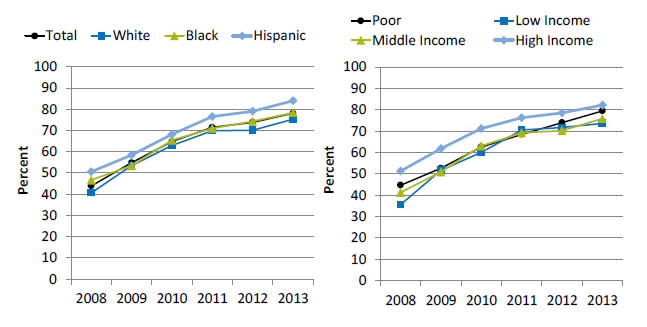
Left Chart:
| Race / Ethnicity | 2008 | 2009 | 2010 | 2011 | 2012 | 2013 |
|---|---|---|---|---|---|---|
| Total | 43.9 | 54.8 | 64.8 | 71.5 | 73.8 | 78.1 |
| Hispanic | 50.6 | 58.5 | 68.2 | 76.6 | 79.0 | 84.0 |
| Black | 46.7 | 53.4 | 65.5 | 71.0 | 74.3 | 78.4 |
| White | 40.7 | 53.4 | 63.0 | 69.9 | 70.1 | 75.3 |
Right Chart:
| Income | 2008 | 2009 | 2010 | 2011 | 2012 | 2013 |
|---|---|---|---|---|---|---|
| Poor | 44.7 | 52.6 | 62.6 | 68.5 | 74.0 | 79.5 |
| Low Income | 35.6 | 51.7 | 60.1 | 70.5 | 71.7 | 73.7 |
| Middle Income | 41.3 | 50.9 | 63.1 | 69.2 | 70.2 | 75.9 |
| High Income | 51.3 | 61.8 | 71.2 | 76.3 | 78.6 | 82.2 |
Source: Centers for Disease Control and Prevention, National Center for Health Statistics and National Center for Immunization and Respiratory Diseases, National Immunization Survey, 2008-2013.
Note: White and Black are non-Hispanic. Hispanic includes all races.
- Overall: In 2013, the percentage of adolescents ages 13-15 who ever received at least 1 dose of the meningococcal vaccine was 78.1%.
- Trends: The percentage of adolescents ages 13-15 who ever received at least 1 dose of the meningococcal vaccine improved overall and for all racial/ethnic groups and income groups.
- Groups With Disparities:
- In 2013, the percentage of Hispanic adolescents (84%) ages 13-15 who ever received at least 1 dose of meningococcal vaccine was higher compared with White adolescents (75.3%).
- In all years, the percentage of adolescents ages 13-15 who ever received at least 1 dose of meningococcal vaccine was lower for those who live in poor, low-, and middle-income households compared with those from high-income households.
Adolescents ages 13-17 years who ever received at least 1 dose of the meningococcal vaccine, by State quartiles, 2014
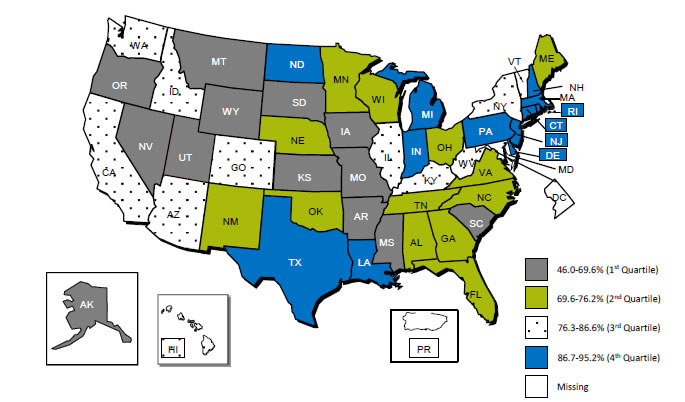
Source: National Immunization Survey-Teen, United States, 2014. http://www.cdc.gov/vaccines/imz-managers/coverage/nis/teen/data/tables-2014.html
Note: Quartile values may overlap due to rounding.
- Overall: This map shows estimated vaccination coverage with at least 1 dose of meningococcal vaccine among adolescents ages 13-17 years, by State. State values ranged from 46.0% (Mississippi) to 95.2% (Pennsylvania).
- Differences by State: Interquartile ranges follow:
- First quartile (lowest): 46.0%-69.6% (AK, AR, IA, KS, MO, MS, MT, NV, OR, SC, SD, UT, WY).
- Second quartile (second lowest): 69.6%-76.2% (AL, FL, GA ME, MN, NC, NE, NM, OH, OK, TN, VA, WI).
- Third quartile (second highest): 76.3%-86.6% (AZ, CA, CO, HI, ID, IL, KY, MD, NY, VT, WA, WV).
- Fourth quartile (highest): 86.7%-95.2% (CT, DE, IN, LA, MA, MI, ND, NH, NJ, PA, RI, TX).
Adolescents ages 13-17 years who ever received at least 1 dose of the meningococcal vaccine, by race/ethnicity, 2014
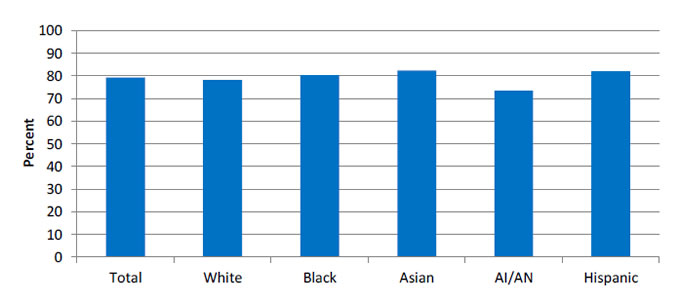
- Total - 79.3.
- White - 78.2.
- Black - 80.3.
- Asian - 82.5.
- AI/AN - 73.5.
- Hispanic - 82.1.
Key: AI/AN = American Indian or Alaska Native.
Source: National Immunization Survey-Teen, United States, 2014. http://www.cdc.gov/vaccines/imz-managers/coverage/nis/teen/data/tables-2014.html
- Overall Rate: In 2014, the estimated vaccination coverage for the meningitis vaccine among all adolescents ages 13-17 was 79.3%.
- Groups With Disparities:
- Hispanics (82.1%) and Asians (82.5%) had the highest coverage.
- American Indians and Alaska Natives (73.5%) had the lowest coverage.
Human Papillomavirus Vaccination Coverage for Adolescents
- Licensed HPV vaccine available since 2006.
- Recommended by the Advisory Committee on Immunization Practices (ACIP) for routine vaccination of girls at age 11 or 12.14,15
- Quadrivalent HPV (HPV4) recommended by ACIP in 2011 for routine vaccination of boys at age 11 or 12.16
- Can be safely given with other routine vaccines; administration of all age-appropriate vaccines during a single visit recommended by ACIP.17
Adolescents ages 13-17 years who received 3 or more doses of human papillomavirus vaccine, by race/ethnicity, stratified by sex, 2013
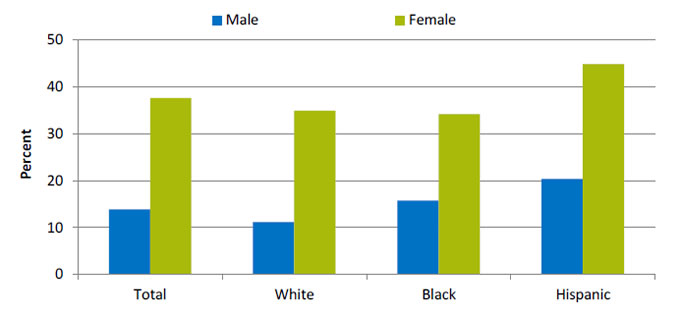
| Race / Ethnicity | Male | Female |
|---|---|---|
| Total | 13.9 | 37.6 |
| White | 11.1 | 34.9 |
| Black | 15.7 | 34.2 |
| Hispanic | 20.3 | 44.8 |
Source: National Immunization Survey-Teen, United States, 2013. http://www.cdc.gov/vaccines/imz-managers/coverage/nis/teen/data/tables-2013.html#pov.
Note: White and Black are non-Hispanic. Hispanic includes all races.
- Overall Rate: In 2013, 37.6% of adolescent females and 13.9% of adolescent males ages 13-17 years received 3 or more doses of the human papillomavirus (HPV) vaccine.
- Groups With Disparities:
- Hispanic females ages 13-17 (44.8%) were more likely than both White (34.9%) and Black (34.2%) females ages 13-17 to have received 3 or more doses of the HPV vaccine. There were no statistically significant differences between White females and Black females.
- Both Black (15.7%) and Hispanic (20.3%) males ages 13-17 were more likely than White (11.1%) males ages 13-17 to have received 3 or more doses of the HPV vaccine. There were no statistically significant differences between White males and Black males.



